The rise of fascism
At the turn of the twentieth century, a wave of philosophical and political ideas swept through the minds of young European intellectuals. Some rallied behind the cause of class struggle, others focused on national unification, and many were captivated by the concept of Übermensch – ‘a superhuman.’
One prominent figure profoundly influenced by these shifting currents of thought was Benito Mussolini, a charismatic young Italian journalist whose rebellious nature often landed him in Italian prisons. Driven by youthful curiosity, Mussolini didn’t merely read – he devoured and translated modern philosophical works, immersing himself in the ideas of Nietzsche, Engels, Marx, Malatesta, Pareto, and other leading intellectuals of the time. These competing ideologies wrestled for dominance in the depths of his mind. One moment, he was a socialist; the next, a nationalist. At times, he embraced pacifism, only to turn into a warmonger; a Bolshevik one day, and a fervent patriot the next. These conflicting currents swirled within him, but it would take time for them to merge into anything resembling a coherent system. Like many rebellious spirits of his generation, Mussolini deliberately rejected the idea of liberal democracy, which he saw as decadent, “rotten,” and outdated.
Toward the end of World War I, or shortly thereafter, the collectivist ideas of nationalism and socialism finally aligned in the mind of the Italian journalist, fusing into a potent, explosive mix whose fatal allure would soon extend far beyond Italy’s borders. Mussolini named this ideology fascism, and it would plunge Italy into the bittersweet hell of totalitarianism, bringing him personal fame, power, and adoration. The unity and pride of the nation were to be the highest goals; class struggle would be replaced by cooperation between classes, and the nation was to be led by an unstoppable, all-encompassing leader – il Duce. To fulfil his historical mission, Mussolini spared no effort in playing the part of the new Caesar, and the public had the daily privilege of watching him in action: flying planes, racing cars, riding horses, taming lions, playing the violin, fencing, skiing, swimming, speaking multiple languages, and juggling numerous mistresses. “Unfortunately, I am no superman like Mussolini,” Mahatma Gandhi once quipped. Though the concept of a personality cult has been replicated countless times since, the original one remains Mussolini’s brainchild. Later cults of personality may have grown larger, lasted longer, or become more sinister, but none could match the reach and all-encompassing authenticity of Mussolini’s original creation.
By that time, Mussolini had mastered the art of tailoring his ideology to resonate with the lower, frustrated, and poorly educated segments of society. He knew part of the elite had to be bribed, while the rest were to be either silenced or side-lined. In pursuit of this, the once-atheist Mussolini even reconciled with the Church, going so far as to renew his marriage in a religious ceremony. Naturally, the opposition was beaten into submission, with one prominent politician even murdered. The media were tightly controlled, and elections – while they still existed – were manipulated. Despite this, Mussolini enjoyed considerable support. Among those disgraced by their backing of fascist rule were Marconi, Pirandello, and D’Annunzio, while Filippo Marinetti and the entire Futurist art movement collectively joined the cause. When Mussolini called on Italians to hand over their gold possessions to support national development, they responded overwhelmingly. Luigi Pirandello, for example, had his Nobel Prize medal melted down. Women removed and donated their wedding rings, and dozens, perhaps even hundreds, gave Mussolini far more than just their jewellery – bestowing upon him all that a woman can offer to an adored alpha male. “It is better to live one day as a lion than a hundred years as a sheep,” Mussolini proclaimed.
Of course, not everyone was swept up in the fervour. At the height of this madness, a science fiction writer predicted that Mussolini would eventually declare war on France, that the war would be lost, and that Mussolini would subsequently be killed by his own people. As fate would have it, this scenario played out exactly as foreseen… but that was still a few years away, and until then, several more years of his unbearable triumph had to be endured.
Art and architecture in the age of fascism
Although Italian art was tightly controlled to serve the grand national cause during the fascist regime, the grip of Mussolini’s rule wasn’t yet as suffocating as in later totalitarian regimes. Jazz, that “dreadful Black music,” secretly found favour even in fascist Italy, much to the open disgust of Mussolini’s fellow dictators, Hitler and Stalin. In fact, Mussolini’s own son would go on to become one of post-war Italy’s most renowned jazz musicians, building an impressive international career. Another of Mussolini’s sons became a prominent film critic and producer during the fascist years, playing a pivotal role in launching the careers of iconic directors Fellini, Antonioni, and Rossellini. His third son distinguished himself as a skilled pilot. Yet, Mussolini’s family life was far from ideal. In his rise to power, he annulled and tried to bury all traces of his first marriage. His talkative son from that union was silenced forever by the secret police. Interestingly, it was his granddaughter Alessandra who inherited much of Benito’s personality. As a young actress, she showcased her charms in full splendour for Playboy, only to later reinvent herself as a far-right conservative politician.
“Degenerate” art, such as abstract, surrealist, and expressionist works, which were so viciously ridiculed in Nazi Germany, remained tolerated in Mussolini’s Italy for quite some time. Marinetti’s Futurists were a leading force in the new Fascist visual arts, although they were criticized for being too international rather than distinctly Italian. Competing with them was Margherita Sarfatti, Mussolini’s influential Jewish mistress and a prominent art critic. She gathered a group of artists willing to reinterpret the traditions of Italy’s rich painting heritage while contributing more directly to Fascist propaganda. This movement was aptly named Novecento Italiano.
In architecture, the early years of Fascist rule were marked by proponents of the Rationalist movement. The Rationalists, a group of young architects from northern Italy, declared that their style would be “something between” – a blend of Novecento and Futurism. As is often the case, a “middle ground” is rarely a good direction for artistic innovation, but their manifesto didn’t fully reflect the truth. In reality, they were key representatives of what would later become known as Modernism or the “International Style” in the U.S. By that time, the pendulum of artistic taste had swung from heavy decoration to a focus on utility, rationality, and the absence of ornamentation. An architect who gained particular prominence was Giuseppe Terragni, best known for his Rationalist masterpiece, the Casa del Fascio, located in the northern Italian town of Como near the Swiss border.
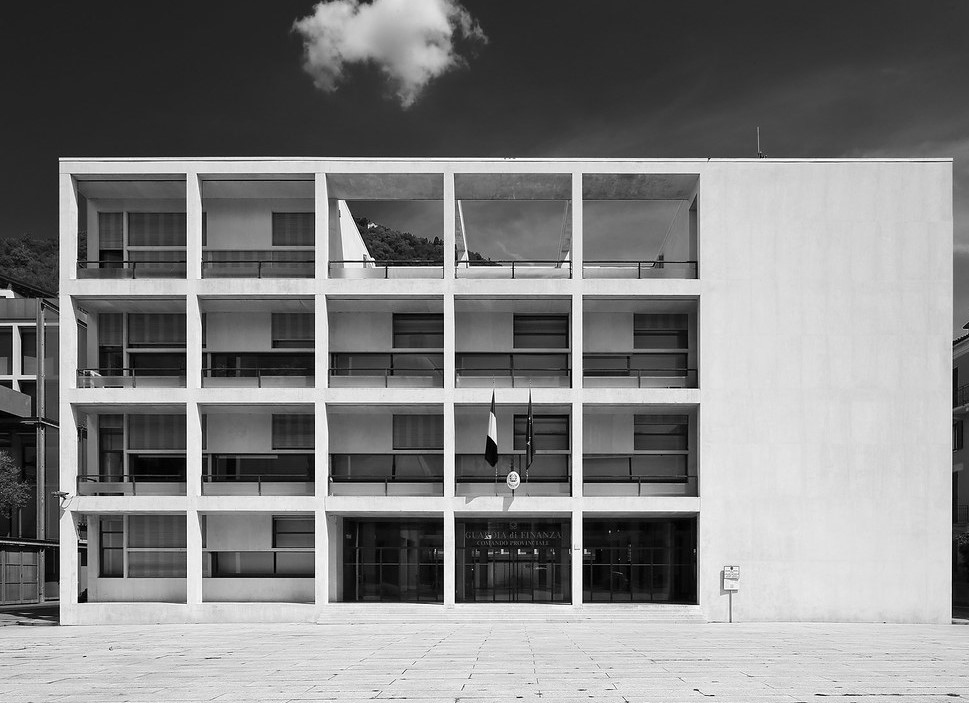
The Casa del Fascio was actually the standard name for local Fascist Party headquarters, and countless buildings were constructed under this label across Italy – probably numbering in the thousands, many in the Rationalist style. Today, a visitor to Como might easily overlook its Casa del Fascio, as its characteristic design has been so widely imitated that it no longer stands out enough to draw attention. Still quietly situated in Como, the building remains relatively unnoticed, flying the flags of Italy and the European Union, and likely serving as a municipal office.
For the time and purpose it was built, the building wasn’t bad, but it fell short of the regime’s grand aspirations. The first obvious issue was that Italian Rationalism couldn’t hold a candle to what was unfolding in the architecture of democratic, liberal, and then much-despised America. More crucially, it lacked distinctively Italian elements, so even the moderate traditionalists got a chance to push for their vision.
The newly founded ideal fascist towns
The architecture of Italian fascism did, however, have one area in which it could truly distinguish itself – the creation of newly established towns and villages meant to project a modern, national, and fascist character. Though some of these settlements were created for other purposes, the most emblematic were built on land reclaimed from ancient swamps. Amid the flood of demagoguery that defined Mussolini’s Fascist government, there were a few tangible achievements, none more striking than the draining of the Pontine Marshes south of Rome – a historic breeding ground for malaria. Efforts to drain this land had begun as far back as the Renaissance, yet it wasn’t until the 1930s that the project finally succeeded, converting the swamp into fertile farmland crisscrossed with orderly canals and roadways. Towns and villages were then purposefully planned on this reclaimed land, with settlers brought in from other parts of Italy. The urbanistic concept was straightforward: each settlement would have a central square with a church, Casa del Fascio, school, town hall, and police station, surrounded by neatly arranged streets with homes for predominantly agricultural workers.
A major architectural conflict, often on the verge of scandal, erupted over the design of the central structures in these newly formed settlements. Proponents of the leading styles – Novecento and Rationalism – fiercely argued and accused one another. Even design competitions, when held, were riddled with dubious practices, always shadowed by accusations, insults, and controversy. The core debate revolved around the balance between Modernism and tradition. Ultimately, Rationalists, Novecentists, and Futurists each got their piece of the pie, but none were as successful in landing the most profitable projects as Modernist architect Concezio Petrucci. A close friend of the Minister of Public Works, Petrucci had a knack for winning these controversial competitions, sometimes even beating out far more compelling proposals. In Sardinia, which also suffered from endemic malaria, a similar swamp-reclamation program was launched. Although it achieved only partial success under Mussolini, it was enough to establish three new towns in typical Fascist fashion: Mussolinia (now Arborea), Carbonia, and Fertilia.
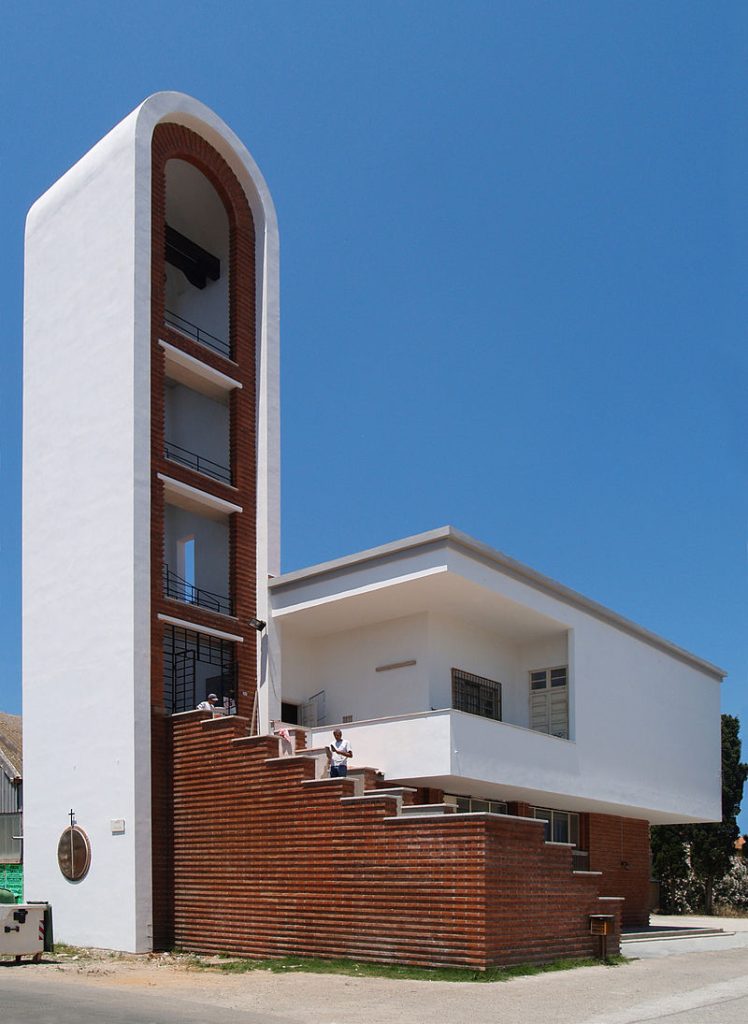
In the competition for the Fertilia project, Petrucci once again took the lead alongside his collaborators, even though the original urban concept, based on the British garden city model, had been drafted earlier by the engineer Arturo Miraglia. With the outbreak of the war, however, both construction and settlement efforts were cut short, leaving buildings unfinished and empty at the war’s end. Only later was Fertilia completed, finally becoming a refuge for those expelled by Yugoslav partisans from Istria, Rijeka, and Dalmatia.
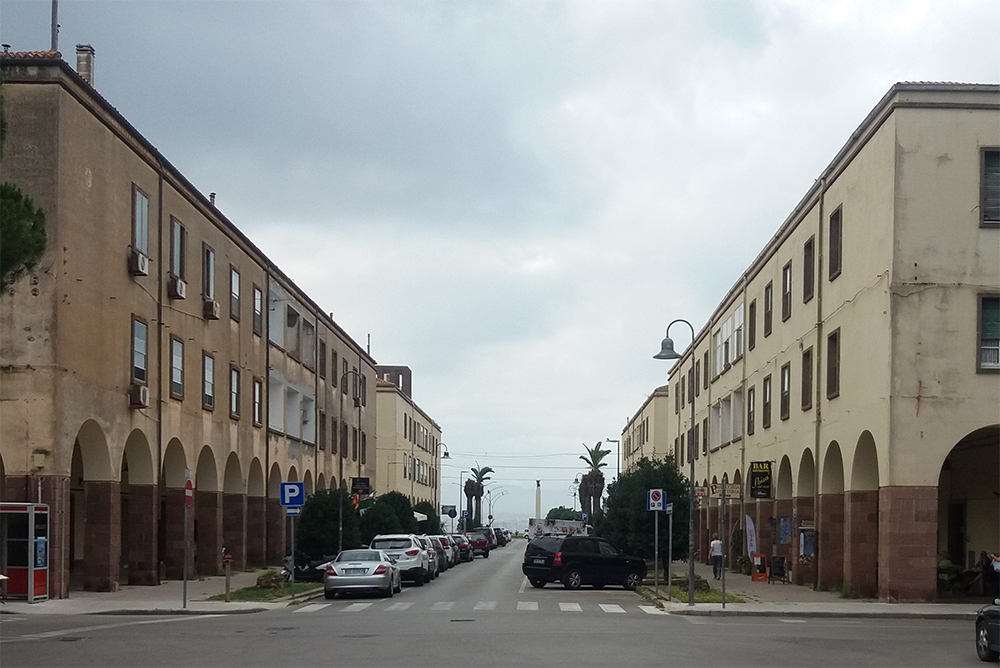
Their descendants still live in that place, whose streets bear nostalgic names from the old region:
Via Fiume (Rijeka), Via Zara (Zadar), Via Cherso (Cres), Via Parenzo (Poreč), Lungomare Rovigno (Rovinj Promenade), Via Dalmazia…. In the center of the town there is a restaurant, whose owner escaped from Rovinj and where, to this day, an Istrian dinner is prepared every Wednesday.
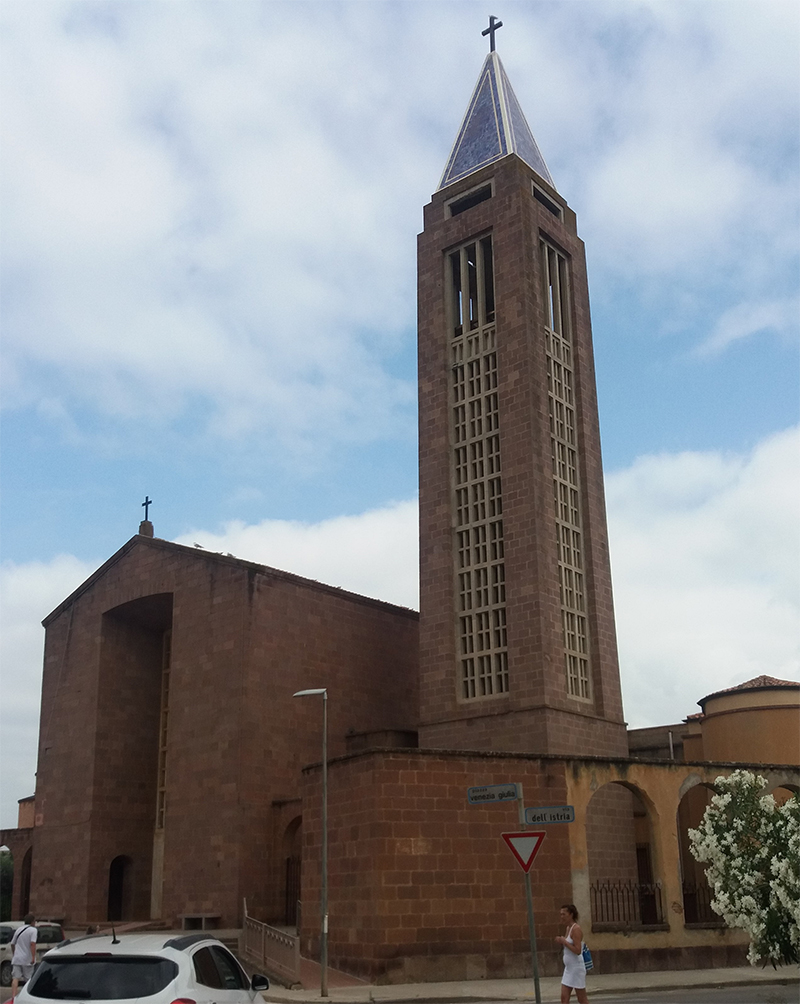
After the war, under the Marshall Plan and with the support of the Rockefeller Foundation, Sardinia was finally cleansed of malaria, and its tourist development began in Alghero – a charming Catalan enclave of the island, known as the “little Barcelona” and located just a few kilometres from Fertilia. While Alghero buzzes with tourists during the summer months, Fertilia remains eerily quiet, half-empty, and steeped in a sense of hopeless nostalgia. The initial vision of a garden city was never fully realized.
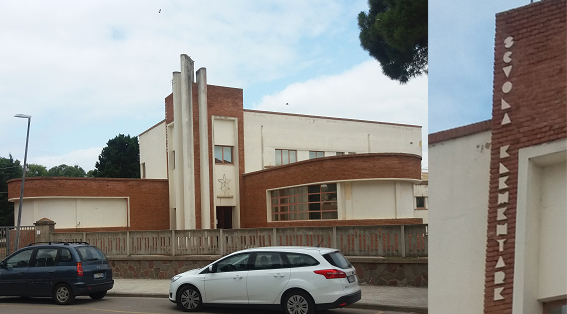
EUR district in Rome
The most ambitious architectural project in Fascist Italy was the construction of the EUR district in the southern part of Rome, intended for the 1942 World’s Fair, officially known as the Esposizione Universale Roma, or simply EUR. This was set to be an ideal opportunity for Mussolini to celebrate twenty years of Fascist rule and showcase the achievements of his country. By the time this project took shape, Mussolini was no longer the eccentric loner at the helm of Europe’s political scene. His fervent admirer, the German National Socialist Adolf Hitler, was now a rival. This was Mussolini’s chance to show both Hitler and a decaying West who still held the reins of power.
Naturally, this was not a project where Mussolini could allow competition from some Rationalists or Futurists. For this task, he appointed the best man he had at his disposal, Marcello Piacentini, as the chief architect, granting him full authority.
Piacentini was an architect with a wealth of experience, who had navigated a variety of styles throughout his career, and during the Fascist era, he proved highly adept at blending modern and traditional expressions. Under the weight of national importance, and with Germany’s rivalry looming, Piacentini had to infuse this project with a grand monumentality, emphasizing ancient Roman motifs – a trend gaining momentum in the final years of Fascist rule.
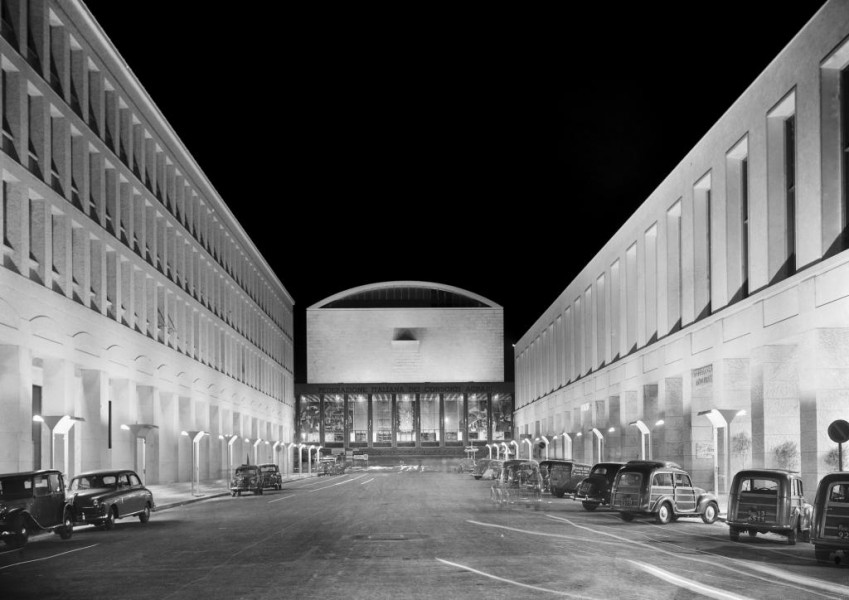
EUR was envisioned as a grand district featuring public buildings, a convention centre, a massive sports arena, an artificial lake, and wide boulevards lined with neo-classical statues and colonnades. Over time, most of these structures, despite their monumental design meant to underscore the era’s significance, have mostly lost their initial allure. Yet, one building still stands out, altering the perception of the entire district. This is the Palazzo della Civiltà Italiana, the Palace of Italian Civilization, often referred to as the Square Colosseum.
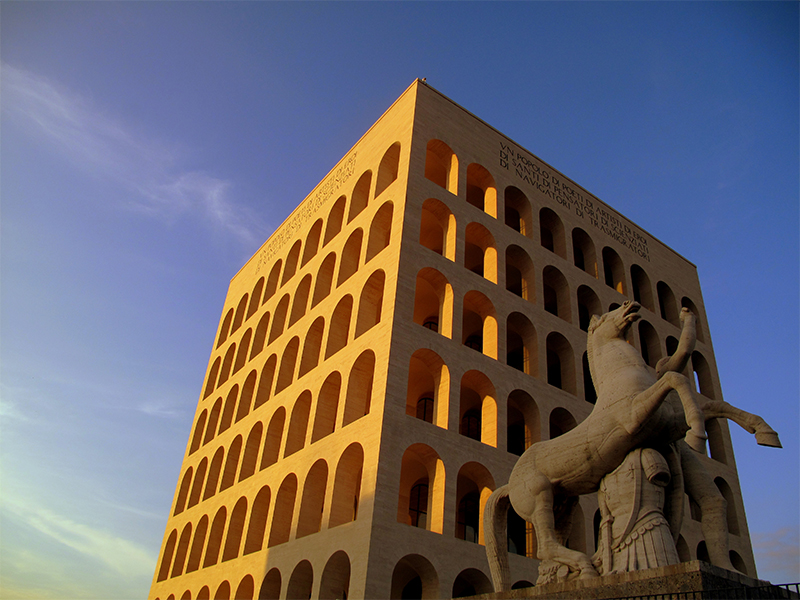
Palace of Italian civilization
Most likely, in line with the reinterpretation of Antiquity, the initial idea was to transpose the iconic arches of the ancient Colosseum onto a building of a different form. Yet once realized, with neo-classical statues placed in the arches of the ground floor, the result was a structure that seems almost otherworldly, serving no clear purpose, as if forever swept by a wind of deep nostalgia. The empty plaza around it, statues in place of people, and the building seemingly devoid of any function all create a surreal atmosphere. It’s no wonder many visitors feel as though they’ve stepped into a “metaphysical” painting by Giorgio de Chirico. And this is precisely the altered perception that defines the entire district.

All four facades of the building are identical, each adorned with a quote about Italian culture from one of Mussolini’s speeches at the top. The arches are arranged in a precise matrix of six types and nine columns on each facade. Some speculate that this configuration is significant: the word “Benito” consists of six letters, while “Mussolini” has nine, but these interpretations remain mere conjecture. The true artistic intentions of the architects – Guerrini, Lapadula, and Romano – remain elusive, sparking curiosity about what was planned and what unfolded unexpectedly. Although the world exhibition was ultimately cancelled due to the war, EUR was constructed, heavily bombed, and later rebuilt, partially in line with the original designs and partially reflecting post-war trends. The main architect, Piacentini, found himself marginalized in the post-war era as the public associated him with the former regime. He taught at the university but struggled to secure significant projects. Yet, when the restoration of EUR gained momentum, he was called upon to contribute his vision. Today, EUR stands as a modern business district distanced from the city centre, home to numerous international companies. The Palace of Italian Civilization is now leased by Fendi, a manufacturer of premium fashion products.
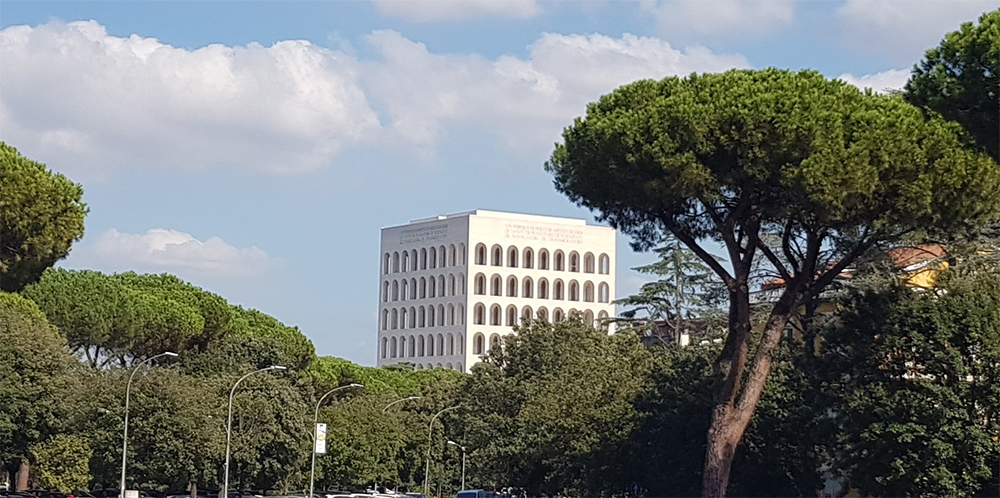
Mussolini’s Legacy
The military defeats shattered the myth of Mussolini as a “superhuman.” In the last two years of the war, he led the Italian Social Republic, which encompassed northern and central Italy. Collaborating with his former youth comrade, the communist Nicola Bombacci, he deepened the socialist elements of fascist ideology, issuing decrees for the nationalization of major enterprises and initiating an early form of workers’ self-management, then termed “the socialization of the economy.”
On the last day of his life, Mussolini attempted to reach the Swiss border or, at the very least, surrender to the American military for a fair trial. His escape route led him through the town of Como. Did he take the moment to cast one last glance at the Casa del Fascio? If he did, was he reminded of his years of triumph, or did it deepen that horrifying sense of life’s transience?
“Future fascists will call themselves anti-fascists,” George Orwell once said. Mussolini’s ideology, under various guises, continued to persist after his death. His imitators, often former communists, openly embraced a blend of nationalism, religion, and a cult of personality, retracing Mussolini’s youthful ideological maturation and his later opportunistic adaptations to the lowest social strata.
In contrast to the ominous ideological legacy, the artistic heritage of Italian fascism is relatively innocuous. Italy is still home to a number of artworks reminiscent of the fascist era. In various public spaces across Rome and Italy, we can encounter propaganda murals, facade reliefs, and monuments depicting Duce and other fascist symbols. These remnants now serve as warnings, portraying a chapter in the nation’s history that most Italians would rather forget.
Darko Veselinović, February 2020



